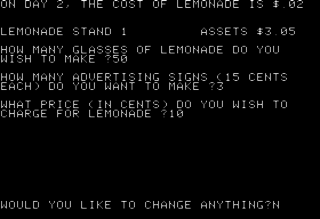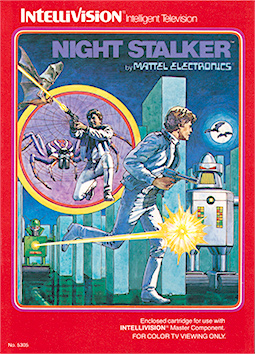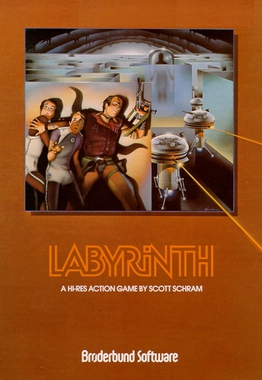
K.C. Munchkin!, released in Europe as Munchkin, is a maze game for the Magnavox Odyssey 2. Its North American title is an inside reference to then president of Philips Consumer Electronics, Kenneth C. Menkin.

Number Munchers is a 1986 video game and a spin-off to the title Word Munchers. It was made by MECC for Apple II, then ported to DOS and Macintosh in 1990. The concept of the game was designed by R. Philip Bouchard, who also designed The Oregon Trail. Two versions of the game were released the Consumer Version and the School Version. After The Learning Company acquired MECC, the game was rebranded as "Math Munchers".

3D Monster Maze is a survival horror computer game developed from an idea by J.K. Greye and programmed by Malcolm Evans and released in 1981 for the Sinclair ZX81 platform with the 16 KB memory expansion. The game was initially released by J. K. Greye Software in December 1981 and re-released in 1982 by Evans' own startup, New Generation Software. Rendered using low-resolution character block "graphics", it was one of the first 3D games for a home computer, and one of the first games incorporating typical elements of the genre that would later be termed survival horror.

Dung Beetles is an Apple II maze game written by Bob Bishop published in 1982 by Datasoft. The gameplay is similar to Pac-Man, but a portion of the maze around the player-controlled character is enlarged as if being viewed through a square magnifying glass.
Munchers is a series of educational/edutainment computer games produced by the Minnesota Educational Computing Consortium (MECC) for several operating systems. The series was popular among American schoolchildren in the 1980s and 1990s and were the recipients of several awards. The two original games in the series were Number Munchers and Word Munchers. The brand name is currently owned by Houghton Mifflin Harcourt, but is defunct.

Drol is a video game published by Broderbund in 1983. It was written for the Apple II by Benny Aik Beng Ngo, then ported to the Commodore 64 and Atari 8-bit computers. Versions were released for the SG-1000 in 1985 and Amiga in 1991.

Lemonade Stand is a business simulation game created in 1973 by Bob Jamison of the Minnesota Educational Computing Consortium (MECC). In it, the player moves through several rounds of running a lemonade stand, beginning each round by making choices dependent on their current amount of money about their stock, prices, and advertising. In each round, the results are randomized based on the player's inputs, as well as affected by random events such as thunderstorms and street closures. Each round ends with a summary of the player's current status, and the game ends after 12 rounds.

Mars Cars is an Apple II maze video game written by David Husch and published by Datamost in 1982.

Snack Attack is a maze video game developed by Dan Illowsky for the Apple II and published by Datamost in 1981. Snack Attack is a Pac-Man clone.

Night Stalker is a top-down maze shooter designed by Steve Montero and released for the Intellivision console in 1982. Night Stalker was ported to the Atari 2600 as Dark Cavern and released under Mattel's M Network label. Apple II, IBM PC, and Mattel Aquarius versions were published in 1983.

Serpentine is a maze video game written by David Snider for the Apple II and published by Broderbund in 1982. Serpentine's gameplay and visuals are similar to the Konami arcade game, Jungler, released the previous year. It was ported to the Commodore 64 and Atari 8-bit computers. A VIC-20 version was licensed to Creative Software.

World's Biggest Pac-Man is a browser game created by Australian website designer Soap Creative along with Microsoft and Namco Bandai Games. It is a Pac-Man game which differed from the original by having multiple players play together in a series of user-created, customizable and interlocking mazes. The game was announced at the Microsoft MIX Developer Conference on 13 April 2011.

Wayout is a 3D first-person perspective video game programmed by Paul Allen Edelstein and published for the Atari 8-bit computers in 1982. It was released for the Apple II and Commodore 64 in 1983. Wayout is among the first maze games to offer full 360 degree 3D perspective and movement, and its graphics were considered state-of-the-art upon its release. There were many pseudo-3D maze games at the time, but they used a fixed perspective and limited the player to four orientations.

Bolo is a video game written by Jim Lane for the Apple II and published by Synergistic Software in 1982. It was inspired by Keith Laumer's 1976 science fiction novel Bolo: Annals of the Dinochrome Brigade, which featured self-aware tanks.

Pepper II is an arcade video game developed by Exidy and published in 1982. Despite its name, there was no predecessor named Pepper or Pepper I. As in Amidar by Konami and Stern Electronics, the goal is to color the lines on a grid; each rectangle is filled-in after being completely surrounded. Coleco published a port of Pepper II for its ColecoVision home system.

Star Maze is a space-themed shooter taking place in a multidirectional scrolling maze published by Sir-Tech in 1982. It was written by Canadian programmer Gordon Eastman for the Apple II, based on a design by Robert Woodhead. Versions for the Atari 8-bit computers and Commodore 64 followed in 1983.

Kid Grid is a grid capture game which borrows heavily from the 1981 arcade video game Amidar. Written by Arti Haroutunian for Atari 8-bit computers, it was published by Tronix in 1982. A Commodore 64 port from the same programmer was released in 1983. In Kid Grid, the player moves along the horizontal and vertical lines of the playfield, turning the lines from dotted gray to solid blue. If all the lines around a square are completed, it is filled-in. Deadly creatures chase the player.

Labyrinth is a maze shooter written by Scott Schram for the Apple II, published in 1982 by Broderbund. It was ported to the Atari 8-bit computers by Corey Kosak.

















